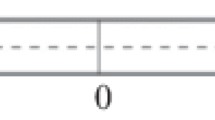Abstract
A spatially one-dimensional model of a plane active double layer between two homogeneous elastic half-spaces is studied analytically. The layer synthesizes a preset smooth trajectory of the controlled boundary between the media without any mechanical support. The outer layer of the coating is a piezoelectric, and the inner layer is a polymer that is transparent for low-frequency sound and opaque for high-frequency sound because of dissipation. An algorithm for controlling the piezoelectric elements of the layer on the basis of signals from surface particle-velocity sensors is proposed, and a method for measuring the particle velocity is developed. Conditions of stability and efficiency of the synthesis are formulated. It is shown that the active layer thickness can be much smaller than the wavelength corresponding to the minimal time scale of the boundary trajectory to be formed. The accuracy of the trajectory synthesis depends on the accuracy of measuring, computing, and actuating elements of the system but does not depend on the vibroacoustic characteristics of the half-spaces separated by the active layer or on the presence of smooth waves in these half-spaces. For the synthesis to be efficient, the operating frequency band and the dynamic range of sensors and actuators should be many times greater than the frequency band and the dynamic range of the trajectory to be formed.
Similar content being viewed by others
References
Active Methods of Acoustic Field Control (Based on Huygens Surfaces) (TsNII Rumb, Moscow, 1982) [in Russian].
A. I. Boiko and V. V. Tyutekin, Akust. Zh. 50, 5 (2004) [Acoust. Phys. 50, 1 (2004)].
Yu. I. Bobrovnitskii, Akust. Zh. 49, 731 (2003) [Acoust. Phys. 49, 620 (2003)].
T. R. Howart, V. K. Varadan, X. Bao, and V. V. Varadan, J. Acoust. Soc. Am. 91, 823 (1992).
J. B. Fahnline and G. H. Koopmann, J. Acoust. Soc. Am. 100, 3539 (1996).
S. J. Elliott, P. Gardonio, T. Sors, and M. J. Brennan, J. Acoust. Soc. Am. 111, 908 (2002).
P. Gardonio, Y.-S. Lee, S. J. Elliott, and S. Debost, J. Acoust. Soc. Am. 110, 3025 (2001).
B. Widrow, IEEE Trans. Antennas Propag. 24, 615 (1976).
V. V. Arabadzhi, J. Low Freq. Noise Vibr. Active Control 16(2), 89 (1997).
H. Kawai, Jpn. J. Appl. Phys., No. 8, 975 (1969).
I. Daubechies, Ten Lectures on Wavelets (Society for Industrial and Applied Mathematics, Philadelphia, 1992; RKhD, Moscow-Izhevsk, 2001).
Author information
Authors and Affiliations
Additional information
__________
Translated from Akusticheski\(\overset{\lower0.5em\hbox{$\smash{\scriptscriptstyle\smile}$}}{l} \) Zhurnal, Vol. 51, No. 2, 2005, pp. 180–188.
Original Russian Text Copyright © 2005 by Arabadzhi.
Rights and permissions
About this article
Cite this article
Arabadzhi, V.V. Active control of normal particle velocity at a boundary between two media. Acoust. Phys. 51, 139–146 (2005). https://doi.org/10.1134/1.1884488
Received:
Issue Date:
DOI: https://doi.org/10.1134/1.1884488




